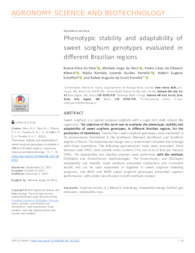Phenotypic stability and adaptability of sweet sorghum genotypes evaluated in different Brazilian regions.
Phenotypic stability and adaptability of sweet sorghum genotypes evaluated in different Brazilian regions.
Author(s): SILVA, R. A. da; SILVA, M. J. da; RIBEIRO, P. C. de O.; PARRELLA, N. N. L. D.; SCHAFFERT, R. E.; PARRELLA, R. A. da C.
Summary: Sweet sorghum is a special purpose sorghum with a sugar-rich stalk, almost like sugarcane. The objective of this work was to evaluate the phenotypic stability and adaptability of sweet sorghum genotypes, in different Brazilian regions, for the production of bioethanol. Twenty-five sweet sorghum genotypes were evaluated in 10 environments distributed in the Southeast, Midwest, Northeast, and Southern regions of Brazil. The experimental design was a randomized complete block design with three repetitions. The following agroindustrial traits were evaluated: fresh biomass yield (FBY), total soluble solids content (TSS) and tons of Brix per hectare (TBH). The adaptability and stability analyzes were performed with the methods GGEbiplot and Annicchiarico methodologies. The Annicchiarico and GGEbiplot adaptability and stability study methods presented satisfactory and consistent results and can be used separately or together in sweet sorghum breeding programs, and B005 and B008 sweet sorghum genotypes presented superior performance, with similar classification in both methods studied.
Publication year: 2022
Types of publication: Journal article
Unit: Embrapa Maize & Sorghum
Keywords: Bioetanol, Sorgo, Sorgo Açucareiro
Observation
Some of Embrapa's publications are published as ePub files. To read them, use or download one of the following free software options to your computer or mobile device. Android: Google Play Books; IOS: iBooks; Windows and Linux: Calibre.
Access other publications
Access the Agricultural Research Database (BDPA) to consult Embrapa's full library collection and records.
Visit Embrapa Bookstore to purchase books and other publications sold by Embrapa.

